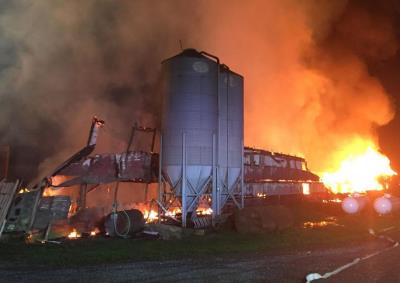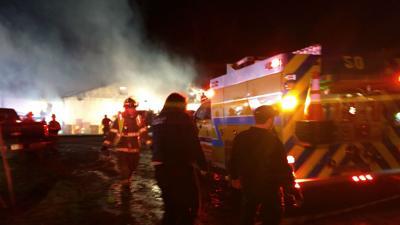 The recent unfortunate conflagration on a farm in Western Michigan resulting in the loss of a cage-free unit with 300,000 hens stimulated a review of fires on egg-production units both in the U.S. and the EU. During 2017 about 1.4 million hens were lost to fire in three incidents in Pennsylvania, Utah and Indiana. In addition to fires involving older high-rise houses there have been a number of incidents involving destruction of newly completed barns and units under construction.
The recent unfortunate conflagration on a farm in Western Michigan resulting in the loss of a cage-free unit with 300,000 hens stimulated a review of fires on egg-production units both in the U.S. and the EU. During 2017 about 1.4 million hens were lost to fire in three incidents in Pennsylvania, Utah and Indiana. In addition to fires involving older high-rise houses there have been a number of incidents involving destruction of newly completed barns and units under construction.
Canada documented the loss of half a million hens in a series of barn fires from 2015 through 2018. It must be remembered that the Canadian controlled marketing system restricts the number of hens on a farm and barns seldom house more than 20,000 birds, suggesting a relatively large number of fires. Between 2017 through late 2019 the Netherlands recorded fires resulting in the loss of 500,000 hens. Again, farms have relatively small barns as producers belong to horizontally integrated cooperatives. In contrast, Germany did not record any losses of hens due to fire. This may be attributed to the fact that fire alarms and sprinklers are mandatory in livestock buildings in this nation.
In reviewing specific cases, malfunction of electrical equipment including overheating motors and substandard wiring are responsible for fires in older high-rise houses. A few cases of losses in newly constructed buildings are attributed to deviations from acceptable structural and electrical codes and defective circuit breakers. It is considered significant that most fires occur at night resulting in total loss of at least the house involved in addition to death and depressed egg production due to smoke inhalation in adjacent houses located on in-line complexes. This obviously points to defective or  absent alarm systems or a delay in the response of managers.
absent alarm systems or a delay in the response of managers.
The large capacity and hence cost of multi-level cage-free aviary housing elevates the financial consequences of a fire. At a nominal $30 per hen housed, a structure and equipment involves an investment approaching $10 million if only one barn is impacted. The value of the flock, depending on age and hence amortization, may range downwards from $1.2 million. To this must be added the loss of income and the costs of disruption and temporary repairs to continue operation.
With increasing capital cost and consequential losses associated with a single incident, insurance companies are reassessing risk. As with floods and hurricanes, any upsurge in claims will result in a reevaluation of premiums and deductibles, placing a greater burden on the insured.
The welfare and public relations aspects of fires which may result in the loss of 300,000 hens in a single barn have yet to be evaluated. In the past, extensive mortality from heat prostration associated with climatic extremes generates considerable criticism of “factory farming”, detracting from the image of the egg industry.
It is axiomatic that the time taken to respond to a fire especially at night in a rural area results in the loss of at least the affected barn. All that first responders can do is to contain a fire and prevent spread to adjacent buildings frequently located too close to prevent secondary loss.
Prevention of fires requires a coordinated approach to the design of buildings and selection of fire-proof construction materials. Wood and pressboard are inexpensive but are inflammable and as a complementary issue are impossible to decontaminate. Given that electrical wiring and installations are the major cause of fires, all new buildings should confirm to the National Fire Protection Association, Fire And Life Safety Animal Housing Facilities Code. This Manual is available from the NFPA at a cost $52 by accessing <www.nfpa.org>.